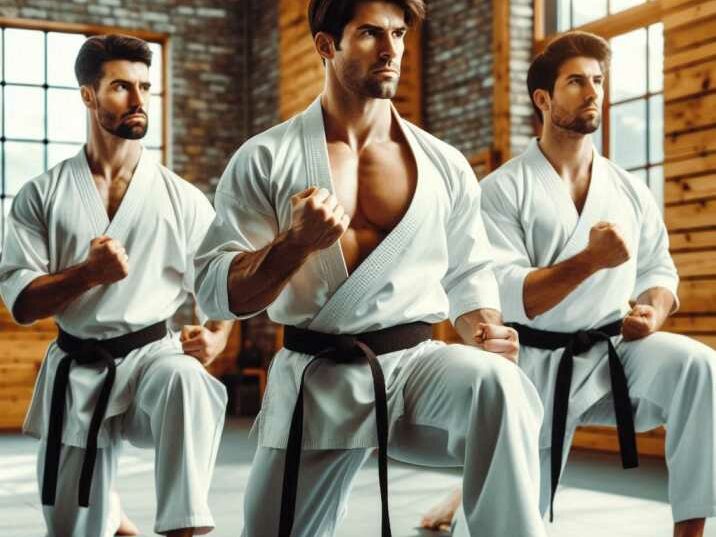When delving into the realm of martial arts, two prominent styles that often emerge are Tang Soo Do vs Taekwondo. Both boast rich histories and distinctive characteristics, yet they also possess notable differences. This comprehensive guide aims to help you understand the nuances of each martial art, assisting you in determining which might be the ideal fit for your journey.
What is Tang Soo Do?
Table of Contents
Origins and Philosophy
Tang Soo Do is a traditional Korean martial art that synthesizes elements from Japanese, Chinese, and indigenous Korean fighting styles. This integration of diverse techniques creates a comprehensive and versatile system of self-defense and personal development.
Origins:
Tang Soo Do’s roots can be traced back to ancient Korea, where martial arts were practiced by the warrior class for self-defense and military purposes. Over centuries, these indigenous techniques were influenced by Chinese martial arts, particularly during the Tang Dynasty, which led to the adoption of various forms and philosophies. Japanese martial arts also contributed to Tang Soo Do’s development during Korea’s occupation by Japan in the early 20th century. The modern form of Tang Soo Do was formalized by Hwang Kee in 1945, who combined these diverse influences into a cohesive martial art.
Philosophy:
Tang Soo Do is deeply rooted in values that extend beyond physical training, emphasizing the development of character and personal growth. Its core philosophical principles include:
- Self-discipline: Self-discipline is essential in Tang Soo Do, as it underpins the consistent practice and mastery of techniques. Practitioners are encouraged to maintain a disciplined training regimen, which helps develop perseverance, focus, and a strong work ethic. This discipline extends to everyday life, fostering a sense of responsibility and commitment in all endeavors.
- Respect for others: Respect is integral to fostering a positive training environment and building strong relationships among practitioners. Tang Soo Do teaches students to show respect to their instructors, peers, and themselves. This respect is manifested through proper etiquette, humility, and a willingness to learn from others. By cultivating a respectful attitude, practitioners create a supportive and collaborative community.
- Personal development: Tang Soo Do encourages continual improvement both mentally and physically. The practice of this martial art promotes physical fitness, enhancing strength, flexibility, and endurance. Mentally, it challenges practitioners to develop focus, discipline, and resilience. Additionally, Tang Soo Do incorporates elements of meditation and mindfulness, promoting inner peace and self-awareness. The ultimate goal is to achieve a harmonious balance between mind, body, and spirit, leading to holistic personal development.
Tang Soo Do is not just about learning self-defense techniques; it is a journey of self-discovery and growth. Practitioners strive to embody the principles of self-discipline, respect, and personal development in their daily lives, making Tang Soo Do a lifelong path to betterment and fulfillment.

Techniques and Training
Tang Soo Do training encompasses a variety of elements:
Striking Techniques
In Tang Soo Do, striking techniques are a cornerstone of training, focusing on a diverse range of hand strikes, kicks, and blocks. Practitioners learn punches, chops, and open-hand strikes to effectively defend and counterattack. Kicks range from basic front kicks to more advanced spinning and jumping kicks, all designed for maximum power and precision. Blocks are essential for defense, teaching students to deflect and neutralize incoming attacks. This comprehensive approach ensures that practitioners develop well-rounded combat skills.
Forms (Hyung)
Forms, known as Hyung in Tang Soo Do, are pre-arranged sequences of movements that practitioners perform individually. These forms are designed to perfect technique, balance, and concentration. Each form simulates a series of defensive and offensive maneuvers against multiple opponents, allowing students to practice and internalize techniques in a structured manner. Hyung not only improves physical coordination but also enhances mental discipline and focus, as students must memorize and execute each sequence with precision.
Sparring
Sparring in Tang Soo Do is typically light-contact, emphasizing safety while allowing practitioners to apply their skills against a live partner. This controlled environment helps students practice timing, distance, and technique in a dynamic setting. Light-contact sparring ensures that practitioners can train intensely without the risk of significant injury, fostering a positive and constructive training atmosphere. It also prepares students for potential real-world confrontations by teaching them to remain calm and focused under pressure.
Self-Defense
Tang Soo Do places a strong emphasis on practical self-defense techniques. These techniques are designed to be efficient and effective, enabling practitioners to protect themselves in real-world situations. Training includes defense against grabs, holds, and strikes, as well as strategies for escaping dangerous scenarios. The self-defense curriculum focuses on simplicity and effectiveness, ensuring that practitioners can confidently and swiftly respond to threats.
Benefits
Practicing Tang Soo Do offers numerous benefits:
Holistic Development
Practicing Tang Soo Do promotes holistic development, encompassing physical conditioning, mental discipline, and spiritual growth. Physically, it enhances strength, endurance, flexibility, and coordination. Mentally, it fosters discipline, focus, and resilience. Spiritually, it encourages personal growth and self-awareness, helping practitioners cultivate a balanced and harmonious life. This well-rounded development is integral to the philosophy of Tang Soo Do, aiming to create well-balanced individuals.
Flexibility and Balance
Tang Soo Do emphasizes precise, controlled movements that enhance overall physical coordination. Training routines incorporate stretching and flexibility exercises to improve range of motion and prevent injuries. Balance is another key focus, as many techniques require stability and control. Practicing Tang Soo Do helps develop a strong core and fine-tune motor skills, leading to improved balance and agility. These physical benefits extend beyond martial arts practice, contributing to overall health and well-being.
Cultural Appreciation
Tang Soo Do provides a deep understanding of Korean martial traditions and values. The art is rooted in the rich history and cultural heritage of Korea, and practitioners are often taught about its origins, philosophies, and customs. This cultural appreciation extends to the respect and etiquette observed in training, fostering a sense of community and respect among practitioners. By learning Tang Soo Do, students gain insight into Korean culture and history, enriching their martial arts journey and broadening their worldviews.
What is Taekwondo?
Origins and Philosophy
Origins
Taekwondo is a modern Korean martial art that has gained immense popularity worldwide, particularly as an Olympic sport. It originated in the mid-20th century, during a time when Korea was reclaiming its cultural identity post-Japanese occupation. The martial art was officially named Taekwondo in 1955, although its development had been ongoing for years. The name “Taekwondo” combines three Korean words: “Tae” (foot), “Kwon” (fist), and “Do” (way of life), symbolizing the art’s focus on kicking and striking techniques as well as its philosophical approach to personal growth.
Philosophy:
Taekwondo’s philosophical underpinnings reflect its dual nature as both a traditional martial art and a modern sport. The key philosophical elements include:
- Speed and Agility: Speed and agility are central to the execution of Taekwondo techniques. Practitioners are trained to develop quick reflexes and the ability to execute rapid, powerful movements. This emphasis on speed is not only for effective self-defense but also for maximizing the impact of strikes. Training routines often include drills designed to enhance reaction time, footwork, and overall agility, ensuring that practitioners can move swiftly and efficiently.
- High, Fast Kicks: One of the hallmarks of Taekwondo is its emphasis on high, fast kicks. These kicks require exceptional flexibility, strength, and precision. Practitioners perform a variety of kicks, including front kicks, roundhouse kicks, and spinning kicks, all aimed at delivering powerful strikes to opponents. The focus on lower body techniques distinguishes Taekwondo from many other martial arts and contributes to its dynamic and visually striking nature.
- Sport and Competition: Taekwondo places a significant emphasis on sport and competition, focusing on athleticism and competitive spirit. It became an official Olympic sport in 2000, which has greatly influenced its training methods and global popularity. Competitive Taekwondo involves both sparring (Kyorugi) and forms (Poomsae). Sparring matches are conducted with strict rules and protective gear, allowing practitioners to test their skills in a controlled environment. The competitive aspect of Taekwondo encourages practitioners to strive for excellence, develop sportsmanship, and build confidence through achieving goals and participating in tournaments.

Techniques and Training
Training in Taekwondo is characterized by:
Kicking Techniques
One of the defining characteristics of Taekwondo is its emphasis on high, dynamic kicks. These kicks are not only powerful but also require exceptional flexibility and precision. Training in Taekwondo involves practicing a wide variety of kicks, including:
- Front Kick (Ap Chagi): A straightforward, powerful kick aimed at the opponent’s midsection or head.
- Roundhouse Kick (Dollyo Chagi): A versatile kick that involves a circular motion to strike the opponent from the side.
- Side Kick (Yeop Chagi): A strong, linear kick aimed at pushing the opponent away.
- Spinning Kicks: Advanced kicks such as the spinning hook kick (Dwi Huryeo Chagi) and the 360-degree kick, which require agility and precise timing.
These kicks are practiced repeatedly to develop muscle memory, speed, and accuracy, making them a formidable part of a practitioner’s arsenal.
Forms (Poomsae)
Forms, known as Poomsae in Taekwondo, are sequences of movements performed in a specific order. These forms are designed to practice and perfect technique, balance, and concentration. Each Poomsae represents a set of offensive and defensive postures against multiple imaginary opponents. Practicing Poomsae helps students develop coordination, precision, and the ability to perform techniques fluidly and correctly. It is a crucial aspect of training that builds a strong foundation in the fundamentals of Taekwondo.
Sparring
Sparring, or Kyorugi, is a critical component of Taekwondo training. Unlike the light-contact sparring in Tang Soo Do, Taekwondo sparring is often full-contact, especially in competitive settings. Practitioners wear protective gear, including headgear, chest protectors, and shin guards, to ensure safety. Sparring sessions teach students how to apply techniques in real-time, improve their timing, and develop strategic thinking. It also helps build confidence and the ability to remain calm under pressure.
Breaking
Breaking, or Kyokpa, is a demonstration of power and precision where practitioners break boards or other materials. This practice showcases the effectiveness of Taekwondo techniques and the practitioner’s control over their strikes. Breaking requires not only physical strength but also mental focus and the ability to generate maximum force with proper technique. It is often used in demonstrations and tests to illustrate the power and accuracy of a practitioner’s skills.
Benefits
Cardiovascular Fitness
Taekwondo training involves high-intensity workouts that significantly improve cardiovascular fitness. The dynamic kicking drills, sparring sessions, and continuous movement during training elevate the heart rate, enhancing stamina, endurance, and overall cardiovascular health. Regular practice helps maintain a healthy weight and reduces the risk of cardiovascular diseases.
Strength and Speed
The rigorous training routines in Taekwondo enhance muscle strength, explosive power, and quick reflexes. The repetitive practice of powerful kicks and the physical demands of sparring develop leg muscles, core strength, and overall body conditioning. Additionally, the emphasis on speed in executing techniques helps practitioners develop quick reflexes and the ability to react swiftly to opponents.
Competitive Opportunities
Taekwondo offers extensive competitive opportunities at regional, national, and international levels. As an Olympic sport, it provides a structured pathway for athletes to compete and achieve recognition. Competitions include sparring matches and Poomsae performances, allowing practitioners to test their skills and gain valuable experience. The competitive aspect of Taekwondo fosters a sense of achievement, sportsmanship, and the drive to excel, providing practitioners with goals to strive for and the motivation to continually improve.
Key Differences Between Tang Soo Do and Taekwondo
Despite their shared Korean heritage and some similarities, Tang Soo Do and Taekwondo diverge in several key areas:
- Focus:
- Tang Soo Do: Prioritizes self-defense, personal growth, and traditional martial practices.
- Taekwondo: Emphasizes sport, agility, and competitive aspects.
- Techniques:
- Tang Soo Do: Offers a balanced array of hand and foot techniques.
- Taekwondo: Places a strong emphasis on powerful, high-flying kicks.
- Training Style:
- Tang Soo Do: Adopts a holistic approach, balancing forms, sparring, and self-defense.
- Taekwondo: Involves rigorous physical conditioning with a strong focus on sparring and athletic performance.
Conclusion
Choosing between Tang Soo Do and Taekwondo hinges on your individual goals and interests. If you seek a martial art that emphasizes balanced development, traditional practices, and practical self-defense, Tang Soo Do may be the ideal fit. Conversely, if you’re attracted to high-energy workouts and the excitement of competition, Taekwondo could be more suitable.
Both martial arts provide remarkable benefits and a lifelong path to fitness, discipline, and personal achievement. Regardless of your choice, embarking on the journey within martial arts will be a rewarding and enriching experience.
FAQs
1. What are the main differences between Tang Soo Do and Taekwondo?
The main differences between Tang Soo Do and Taekwondo lie in their focus and techniques. Tang Soo Do emphasizes a balanced array of hand and foot techniques, traditional forms, and practical self-defense, prioritizing personal growth and holistic development. Taekwondo, on the other hand, is renowned for its high, dynamic kicks, full-contact sparring, and competitive nature, focusing on speed, agility, and athleticism.
2. Which martial art is better for self-defense, Tang Soo Do vs Taekwondo?
Both Tang Soo Do and Taekwondo offer effective self-defense techniques, but their approaches differ. Tang Soo Do’s training includes a comprehensive range of hand strikes, kicks, and blocks designed for real-world self-defense scenarios, making it highly practical. Taekwondo also provides self-defense training but emphasizes kicking techniques and agility. The best choice depends on your personal preference and the specific skills you want to develop.
3. Can I compete in tournaments with either Tang Soo Do vs Taekwondo?
Yes, both Tang Soo Do and Taekwondo offer competitive opportunities. Taekwondo is particularly well-known for its competitive aspect, being an Olympic sport with extensive regional, national, and international tournaments. Tang Soo Do also has competitions, though they may be less widespread than those in Taekwondo. Both martial arts provide avenues for testing skills and achieving recognition through competition.
4. What are the physical benefits of practicing Tang Soo Do and Taekwondo?
Practicing Tang Soo Do and Taekwondo offers numerous physical benefits, including improved cardiovascular fitness, increased strength and flexibility, better balance and coordination, and enhanced overall physical conditioning. Tang Soo Do emphasizes holistic development, promoting flexibility and balance through controlled movements. Taekwondo focuses on strength and speed, with high-intensity workouts that improve stamina and explosive power.
5. How long does it take to achieve a black belt in Tang Soo Do vs Taekwondo?
The time it takes to achieve a black belt in either Tang Soo Do vsTaekwondo varies based on the individual’s dedication, training frequency, and the specific requirements of the school or organization. On average, it can take around 3 to 5 years of consistent training to earn a black belt in both martial arts. However, this timeline can vary significantly, with some students taking longer to achieve this level of proficiency.


